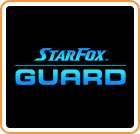When Shigeru Miyamoto revealed Project Guard at E3 2014, I wasn’t impressed. The title seemed gimmicky and uninteresting, and while I trust the man behind it there are never guarantees when it comes to games. I forgot about it over time: another bad sign in terms of what it could be when it was finally released. Fast forward to March’s Nintendo Direct and it was retitled Star Fox Guard, a pack-in with the initial run of Star Fox Zero, or an extra download off of the eShop. This fresh coat of paint still didn’t sell me on the game and its concept, and while it’s nice that the project wasn’t shelved, it needed to somehow stand out on its own merits and exist in the Star Fox universe. Now that I’ve gotten to play the title, I’m sorry I ever doubted the inherent fun of its core idea and am pleased to report that it’s a great side dish to Zero’s full course, though one that only scratches the surface of its ingredients.
“A Tale of Two Frogs”
Star Fox games have never been known for their gripping narratives, and in that respect Guard emulates its predecessors. The only thing with any grip in this one is Grippy Toad, Slippy’s newly introduced uncle that rests at the center of what premise there is. As the head of the Cornerian Precious Metals mining company, Grippy hires you, the player, as head of security for the highly important towers at the center each mining site. The added security is needed because robots have been rustling resources from the established sites– and that’s all the game gives you. No reason as to why these robots are after the materials or a connection to the established, albeit light, Star Fox lore are given. While Slippy eventually started to wonder the same things as me in the game, it was all a bit too late, though that still beats it never happening at all.

So no, this is not something to be played expecting emotionally charged debates on robot ethics weighed against capitalist developments across multiple homesteads. And for this game, that’s okay. As a dressed up concept, it works well enough to add flavor to what could have been an otherwise bare-bones and bland affair. Grippy doesn’t bring much in terms of character, but Slippy’s attitude towards him at times was definitely a treat, creating a small dynamic between the pair that I wish was expanded on. With the introductions out of the way, the game has you contracted and behind the controls of the Slippy-designed Aegiscam system, ready to fight off the invading robots in what I can only describe as a multi-display first-person tower-defense security simulator.
Caught in the camera’s eye
Every stage of Star Fox Guard takes place in a series of angular corridors with a dozen laser-toting security cameras at your command. On the TV screen, this is achieved with a border of the 12 different cameras placed around the edge, with whichever you’ve deemed your focal point enlarged and placed in the center. Before a round begins, these cameras can be moved as you see fit. Over time, different types of cameras can be earned, such as a model that can lock onto five targets at once before firing. These add some variety and strategy, but ultimately, I relied on the game’s default placements and the routine cameras which served me just fine. Once a round begins, robots will advance from multiple angles in an attempt to reach the tower within your base and by tapping the camera icons on the GamePad you switch the focal point, allowing you to keep tabs on everything. Only the focal camera allows you to fire lasers as well, making it your single form of defense. This asymmetrical gameplay creates a rhythm of scanning the entire screen, switching to a camera that has robots within its view, clearing them out, and moving on to the next.

The dual screened approach took some getting used to, especially when the GamePad’s map layout also shows robot icons moving through the mining sites. This eventually evolves to an understanding of using the GamePad to pinpoint areas that need the most attention once robots have made their way inside, though the camera feeds are only ever on the TV screen. It’s unfortunate that the primary feed can’t also be on the GamePad, especially considering how well Star Fox Zero uses the controller for its cockpit view. This fact didn’t exactly lessen the fun I was having, though it did seem a bit odd, all things considered.
Precious metals
The game’s true joy comes after progressing further and encountering more robot types. Robots are divided into Combat class and Chaos class, with Combat being the ones that head directly to the Tower and Chaos making this task easier for their other robots by disrupting your camera feeds in multiple ways. By destroying Combat class robots points are earned based on their durability, with each stage having a set number of points needed to successfully defend. If even one Combat class robot reaches the Tower, you’ve lost. Each robot brings something new and interesting to the gameplay, though the Chaos class is where the creativity shines. One particular robot resembled a television with arms and hands that would fly to my cameras and hold them, replacing my video feed with a still image of the corridor to make it look like everything was fine. Blasting them off my monitors was all too rewarding, with that same sense of joy coming from taking out its equally annoying compatriots.

While the core game design is fun and the roll-out of new robots and cameras as your in-game rank increases encourages progression, it never really goes beyond what it is from the first mission. You’re still controlling cameras, firing lasers and stopping robots. Even if missions take place in different mining sites, all this translates to is a separate layout rather than greater changes to the formula. Extra missions unlocked over time shake things up, such as having robots parachute in instead of walk, but all in all I found myself tiring of the game after a while. Thankfully, this is a game best played with company. While there are no inherent local multiplayer features or modes, the multiview approach makes for a great party game. With friends calling out threatened camera views and known robot types, it makes the game more accessible when it becomes challenging and more tolerable when it becomes tedious. Some of the most fun had with the game involved shouting matches over which camera should be focused on at a given time and the sense of team-based accomplishment after a narrowly completed mission makes the game all the more worthwhile than it is playing solo.
Unearthed extras
The online mode within Star Fox Guard is another highlight, though it’s one that will depend on how the game takes off with those who play it regularly. Players are able to develop their own robot invasion patterns based on what they’ve unlocked in the game so far and upload them for others to defend against. The in-game challenges can already be daunting, and if even a fraction of the ingenuity that’s been seen in the likes of Super Mario Maker goes into Guard’s online mode, there may well be some great challenges on the horizon. That said, the mode is somewhat sparse with only its own set of unlockable symbols and a player ranking to motivate players to give it a go.
While they don’t allow any unlocks like they do in Zero, the Fox and Falco amiibo are both compatible with Guard as well. Before a mission, either can be scanned to allow a one time air-to-ground support run from the Star Fox crew. They’ll clear the map of any robots, serving as a great lifesaver in particularly tense situations. This can only be done once per day per figure, so definitely make it count. That said, I never felt inclined to rely on them, almost preferring to rely on my own skills than that of the mercenary pilots. Still, having the feature present is welcome– and it even includes voiced lines from Fox himself alongside a familiar bit of music.

At its core
Star Fox Guard, as a free addition to Star Fox Zero, is a short and enjoyable game. It challenges the player to understand each individual robot and the timing inherent to each of their actions, creating a rewarding experience for anyone willing to give it a chance. It’s an exercise in spatial awareness, though it never fully grows to be something that begs to be played. I can’t say with certainty if I’d have ever given the game a chance if it weren’t packaged with Zero, but as fate would have it, I’m now on board with the Guard gameplay concept. For those purchasing Zero via the eShop, I’d say Guard’s worth the reduced price of admission though don’t expect much without being able to get some friends together for the occasional session. For anyone passing up on Star Fox Zero in the first place, the small amount of missions and lack of overall gameplay variety makes Guard a hard sell.
Leave a Comment
System: Wii U
Release date: Apr 22, 2016
Category: Action, Strategy
Publisher: Nintendo
Developers: Platinum Games, Nintendo Entertainment Planning & Development

